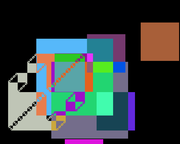
Display hack
Encyclopedia

Computer program
A computer program is a sequence of instructions written to perform a specified task with a computer. A computer requires programs to function, typically executing the program's instructions in a central processor. The program has an executable form that the computer can use directly to execute...
with similar purpose to a kaleidoscope
Kaleidoscope
A kaleidoscope is a circle of mirrors containing loose, colored objects such as beads or pebbles and bits of glass. As the viewer looks into one end, light entering the other end creates a colorful pattern, due to the reflection off the mirrors...
: to make pretty pictures (symmetrical or otherwise). Famous display hacks include munching squares and smoking clover
Smoking clover
According to the Jargon File, Smoking clover is a computer display hack, originally created by Bill Gosper. Several converging lines are drawn on a color monitor in such a way that every pixel struck has its color incremented—altered to the next hue up or down. The color map is then...
. Some display hacks can be also implemented by creating text files which contain numerous escape sequence
Escape sequence
An escape sequence is a series of characters used to change the state of computers and their attached peripheral devices. These are also known as control sequences, reflecting their use in device control. Some control sequences are special characters that always have the same meaning...
s for a text terminal to interpret. A famous example on the VT100
VT100
The VT100 is a video terminal that was made by Digital Equipment Corporation . Its detailed attributes became the de facto standard for terminal emulators.-History:...
terminal displayed a Christmas tree
Christmas tree
The Christmas tree is a decorated evergreen coniferous tree, real or artificial, and a tradition associated with the celebration of Christmas. The tradition of decorating an evergreen tree at Christmas started in Livonia and Germany in the 16th century...
, with twinkling lights and a toy train
Toy train
A toy train is a toy that represents a train. It is distinguished from a model train by an emphasis on low cost and durability, rather than scale modeling. A toy train can be as simple as a pull toy that does not even run on track, or it might be operated by clockwork or a battery...
circling its base. The XScreenSaver
XScreenSaver
XScreenSaver is a collection of about two hundred free screensavers for Unix and Mac OS X computers. It was created by Jamie Zawinski in 1992 and is still maintained by him....
software contains a large collection of X Window System
X Window System
The X window system is a computer software system and network protocol that provides a basis for graphical user interfaces and rich input device capability for networked computers...
and OpenGL
OpenGL
OpenGL is a standard specification defining a cross-language, cross-platform API for writing applications that produce 2D and 3D computer graphics. The interface consists of over 250 different function calls which can be used to draw complex three-dimensional scenes from simple primitives. OpenGL...
display hacks.
Display hacks have a history of several decades. Arguably the first display hack was a program called Bouncing Ball on the Whirlwind computer
Whirlwind (computer)
The Whirlwind computer was developed at the Massachusetts Institute of Technology. It is the first computer that operated in real time, used video displays for output, and the first that was not simply an electronic replacement of older mechanical systems...
in the early 1950s. The famous munching squares hack, on the other hand, originates in the PDP-1
PDP-1
The PDP-1 was the first computer in Digital Equipment Corporation's PDP series and was first produced in 1960. It is famous for being the computer most important in the creation of hacker culture at MIT, BBN and elsewhere...
computer in ca. 1962.
Crack intro
Crack intro
A crack intro, also known as a cracktro, loader, or just intro, is a small introduction sequence added to cracked software, designed to inform the user of which "cracking crew" or individual cracker was responsible for removing the software's copy protection and distributing the crack...
s, display hacks programmed by software crackers
Software cracking
Software cracking is the modification of software to remove or disable features which are considered undesirable by the person cracking the software, usually related to protection methods: copy protection, trial/demo version, serial number, hardware key, date checks, CD check or software annoyances...
for the home computer
Home computer
Home computers were a class of microcomputers entering the market in 1977, and becoming increasingly common during the 1980s. They were marketed to consumers as affordable and accessible computers that, for the first time, were intended for the use of a single nontechnical user...
s of the 1980s, evolved into what was to be known as demos
Demo (computer programming)
A demo is a non-interactive multimedia presentation made within the computer subculture known as the demoscene. Demogroups create demos to demonstrate their abilities in programming, music, drawing, and 3D modeling...
and demo effect
Demo effect
Demo effects are computer-based real-time visual effects found in demos created by the demoscene.The main purpose of demo effects in demos is to show off the skills of the programmer...
s. The creation of demos later became a subculture of its own, now known as the demoscene
Demoscene
The demoscene is a computer art subculture that specializes in producing demos, which are non-interactive audio-visual presentations that run in real-time on a computer...
.
External links
- The Origin of SpaceWar, an article by J. M. Graetz originally published in the August, 1981 issue of Creative ComputingCreative ComputingCreative Computing was one of the earliest magazines covering the microcomputer revolution. Published from 1974 until December 1985, Creative Computing covered the whole spectrum of hobbyist/home/personal computing in a more accessible format than the rather technically-oriented BYTE. The magazine...
magazine, mentions some early display hacks.

